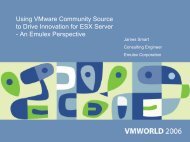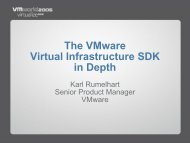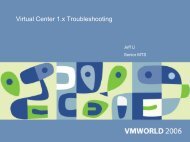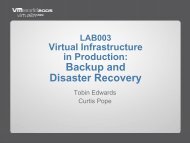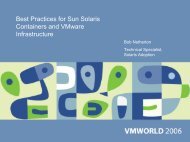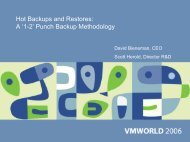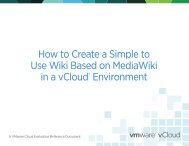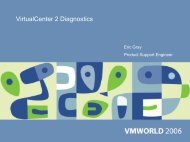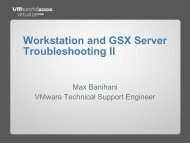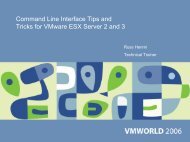Cloud Readiness Self-Assessment Report - VMware
Cloud Readiness Self-Assessment Report - VMware
Cloud Readiness Self-Assessment Report - VMware
Create successful ePaper yourself
Turn your PDF publications into a flip-book with our unique Google optimized e-Paper software.
<strong>Cloud</strong> <strong>Readiness</strong><strong>Self</strong>-<strong>Assessment</strong> <strong>Report</strong>February 23, 2011Generated for Yu-Ting Huang
<strong>Cloud</strong> <strong>Readiness</strong> <strong>Self</strong>-<strong>Assessment</strong> <strong>Report</strong>February 23, 2011Generated for Yu-Ting HuangDear Yu-Ting Huang ,Thank you for taking <strong>VMware</strong>’s <strong>Cloud</strong> <strong>Readiness</strong> <strong>Self</strong>-<strong>Assessment</strong> tool. Based on your responses, we havealso identified key actions you should consider to more fully realize the business benefits of cloud computing.<strong>VMware</strong> customers and partners have successfully implemented cloud computing to increase business agilityand reduce costs. But in order to enjoy the benefits, IT organizations first need to develop and execute a planthat addresses both business-related and technical-related areas. The self-assessment and this reportaddresses the five critical business and technical domains required to make the most effective use of cloudcomputing.Results OverviewAs shown by your results, Architecture and Technology is your strongest point. You have taken the firststeps to identify the potential limitations of your current infrastructure, the desired capabilities of the futureinfrastructure, and the technology gaps you need to bridge. Continue to work on documenting that into areference architecture and developing a roadmap to transition to future state. Meanwhile, it’s important to alignthe capabilities of the architecture to the business goals. Specific recommended next steps are in the ResultsDetailed section.
<strong>Cloud</strong> <strong>Readiness</strong> <strong>Self</strong>-<strong>Assessment</strong> <strong>Report</strong>February 23, 2011Generated for Yu-Ting HuangArchitectureOnce the defined strategy shows clear alignment with business and IT goals, the capabilities ofthe future infrastructure need to be identified. It is important to ensure the new cloudarchitecture aligns with the existing IT architecture to ensure maximum compatibility and re-useof existing resources. At your stage, we recommend the following key next steps:• Formalize cloud computing architecture, whether as a standalone or part of the enterprisearchitecture; complete reference architecture and obtain approval.TechnologyGetting your IT infrastructure to the cloud state requires a technology review to ensure thatthe recommended architecture can be deployed by extending existing infrastructure and toolsacross cloud environments. It is critical to identify upfront what existing technologies can beleveraged or requires maintenance, and what new technologies should be acquired andintegrated. At your stage, we recommend the following key next steps:• Define and devleop the stepwise evolutionary roadmap to future state, with milestones identified; obtainapproval and budget for the plan.People and OrganizationOrganizational barriers are a major inhibitor of successful deployment of new IT strategies –usually a result of lack of a governance model, and skills and training. To successfully adoptcloud computing, services must now be created and shared by multiple constituents across theenterprise. Successful sharing of these services and processes require a governanceframework - collaboration and decision-making policies that specify accountability for eachstakeholder.Understanding and creation of roles and skills to ensure company-wide adoption to support cloud computing isan often over-looked area. IT’s role is evolving with cloud computing and new skills are required in this newenterprise cloud infrastructure. At your stage, we recommend the following key next steps:• Increase your team's basic understanding of cloud computing and industry solutions to prepare for and/orsupport experimentation project. Explore vendor options and capabilities.• Consider creating a cloud steering committee that includes the project sponsor and representatives fromteams impacted by the cloud experimentations. Use the group to align projects with business goals andfacilitate sharing of knowledge.How <strong>VMware</strong> Can Help• Engage with <strong>VMware</strong> v<strong>Cloud</strong> Accelerator Service to establish a working, pre-production <strong>VMware</strong> v<strong>Cloud</strong>computing environment running your applications to demonstrate the value to your organization, or locate
<strong>Cloud</strong> <strong>Readiness</strong> <strong>Self</strong>-<strong>Assessment</strong> <strong>Report</strong>February 23, 2011Generated for Yu-Ting Huangone of <strong>VMware</strong>'s v<strong>Cloud</strong> Powered service providers to try public cloud services.• Set up a workshop with <strong>VMware</strong> Professional Services for your organization to determine your readiness forcloud computing.• Attend <strong>VMware</strong> events or webinars to learn more about <strong>VMware</strong> solution capabilitiess.<strong>VMware</strong> TechnologyThe enterprise hybrid cloud combines the best of both cloud deployment models – the enterprise-scale security,quality of service and performance of a private cloud, with the flexibility and scalability of a public cloud. Thismodel allows public clouds to interoperate with private cloud infrastructures to help IT function with greateragility:• Workloads, virtual machines and applications can port easily between private and public clouds in responseto changing business conditions.• Performance isn’t subject to the whims of other cloud tenants’ requirements. Instead, compute, memory andstorage resources may be guaranteed for the enterprise’s own environment, either on shared or physicallyseparated hardware.• A single command-and-control dashboard monitors, manages and automates the infrastructure, applications,operations and processes across different cloud environments.• The same level of enterprise-class cloud security and management is provided across both internal andexternal environments.<strong>VMware</strong> offers the technologies and services to build your hybrid cloud, your way. First, <strong>VMware</strong>'s completeportfolio of cloud infrastructure and management, cloud application platform and end-user computing solutionsenables you to implement, manage and secure a cloud computing architecture that is compatible across bothprivate clouds and public clouds. Our proven solutions preserve existing investments while accelerating yourability to leverage interoperable and secure hybrid computing environments.• <strong>VMware</strong> v<strong>Cloud</strong> Director - Pool virtual infrastructure resources and deliver them as a catalog-based service• <strong>VMware</strong> vCenter Chargeback - Model, measure and assign costs of virtual machines• <strong>VMware</strong> vShield - Protect all elements of the private cloud - host, network, application, data and endpoint• <strong>VMware</strong> vCenter Server - Unify and simplify virtual machine management• <strong>VMware</strong> vSphere Enterprise Plus - Build private clouds and bridge to public clouds, creating hybrid clouds• <strong>VMware</strong> v<strong>Cloud</strong> Request Manager - Initiates pre-defined workflows to coordinate approvals, track softwarelicenses, and adhere to policy blueprints• <strong>VMware</strong> vCenter CapacityIQ - enables capacity modeling, insight and intelligence, reducing risk and enablinginformed decision-makingTo complete your hybrid cloud infrastructure, <strong>VMware</strong> also offers you the choice of using a broad array ofv<strong>Cloud</strong> Powered service providers, giving you freedom of choice and flexibility. When choosing a serviceprovider for cloud computing services, there are three key requirements:1. Compatibility and portability of your existing <strong>VMware</strong> virtual machines. You want it to be easy to put your
<strong>Cloud</strong> <strong>Readiness</strong> <strong>Self</strong>-<strong>Assessment</strong> <strong>Report</strong>February 23, 2011Generated for Yu-Ting Huangexisting applications into the cloud with little or no changes. It should also be easy to move workloadsback to your own organization to avoid getting "locked in."2. Security and transparency of the cloud platform. You should understand the security controls and haveaccess to logs and other information so you can conduct an audit. You should also get fine-grainedcontrol of what each user can do and be able to define a firewall and network topology for groups ofcooperating virtual machines.3. <strong>Self</strong>-service capabilities while retaining control of cloud resource consumption. You want to be able todelegate responsibility and control to individuals within your organization while setting bounds on thecompute, memory and storage consumption.With <strong>VMware</strong> you have the flexibility of an entry-level cloud with v<strong>Cloud</strong> Express, or you can choose to migrateto an enterprise-class hybrid cloud environment with v<strong>Cloud</strong> Datacenter Services.• <strong>VMware</strong> v<strong>Cloud</strong> Datacenter Services: offered through <strong>VMware</strong>-certified service providers and built on<strong>VMware</strong> cloud infrastructure with compatible management and security, deliver unparalleled security,application portability and business agility to organizations of all types. These enterprise-class, hybrid cloudservices are co-branded and delivered by <strong>VMware</strong> certified service providers.• <strong>VMware</strong> v<strong>Cloud</strong> Express: co-branded and delivered by leading service providers, offers reliable, on-demand,pay-as-you-go infrastructure. Developers in enterprises can quickly start using v<strong>Cloud</strong> Express forprototyping, test and development.Additionally, you can choose from a list of service providers with the following service badges who offer cloudservices built on <strong>VMware</strong> technology.• <strong>VMware</strong> Virtualized: A service badge for any public cloud service based on <strong>VMware</strong> vSphere.• <strong>VMware</strong> v<strong>Cloud</strong> Powered:A service badge for any public/hybrid cloud service based on <strong>VMware</strong> vSphereand <strong>VMware</strong> v<strong>Cloud</strong> Director that exposes the <strong>VMware</strong> v<strong>Cloud</strong> API and supports the Open VirtualizationFormat (OVF) for image upload and download. Both v<strong>Cloud</strong> Datacenter Services and v<strong>Cloud</strong> Express are<strong>VMware</strong> v<strong>Cloud</strong> Powered.Locate a service provider.<strong>VMware</strong> ResourcesMore information about <strong>VMware</strong>’s products and services:• <strong>VMware</strong> <strong>Cloud</strong> Computing Solutions web page• <strong>VMware</strong> and <strong>Cloud</strong> Computing Solution Brochure• <strong>VMware</strong> v<strong>Cloud</strong> Director Datasheet• <strong>VMware</strong> v<strong>Cloud</strong> Request Manager Datasheet• <strong>VMware</strong> vCenter Chargeback Datasheet• <strong>VMware</strong> vShield Product Family Brochure• <strong>VMware</strong> vCenter CapacityIQ Datasheet
<strong>Cloud</strong> <strong>Readiness</strong> <strong>Self</strong>-<strong>Assessment</strong> <strong>Report</strong>February 23, 2011Generated for Yu-Ting Huang• <strong>VMware</strong> v<strong>Cloud</strong> Datacenter Solution Brief• <strong>VMware</strong> v<strong>Cloud</strong> Express web page• <strong>VMware</strong> v<strong>Cloud</strong> Jumpstart Service Sheet• <strong>VMware</strong> v<strong>Cloud</strong> Accelerator Service SheetRead IT Process Institute’s strategy briefs:• IT Value Transformation Roadmap: Vision, Value and Virtualization• Evolving Objectives: Measuring The Value of TransformationRegister for the Global <strong>Cloud</strong> Computing Adoption Trends Kit: CIO Market Pulse <strong>Report</strong> - Global <strong>Cloud</strong>Computing Adoption: Transformation Is in the Air. This four page special exclusive executive summary reviewsthe results of the research: how today's global enterprises are adopting cloud computing, what the key driversare, and the critical role of IT executive leadership as the organization embarks on this new era of IT. SurveyResults - CIO Global <strong>Cloud</strong> Computing Adoption. This presentation provides details of the survey methodology,questions and results, and the respondent's profile.Read about <strong>VMware</strong>’s customers' successful adoption of cloud computing:• BlueLock and Marian College• TeradataVMWare, Inc. 3401 Hillview Avenue Palo Alto CA 94304 USA Tel 877-486-9273 Fax 650-427-5001 www.wmware.comCopyright © 2011 <strong>VMware</strong>, Inc. All rights reserved. This product is protected by U.S. and international copyright and intellectual propertylaws. <strong>VMware</strong> products are covered by one or more patents listed at http://www.vmware.com/go/patents. <strong>VMware</strong> is a registeredtrademark or trademark of <strong>VMware</strong>, Inc. in the United States and/or other jurisdictions. All other marks and names mentioned hereinmay be trademarks of their respective companies.



